19 June 2014 – fantastic victory for Muckaty Traditional Owners in their battle to stop the imposition of a nuclear waste dump by the federal government! Here are some videos, photos and information.
Updates and more info:
www.beyondnuclearinitiative.com
https://twitter.com/hashtag/muckaty
https://www.google.com.au/search?q=muckaty
https://www.facebook.com/beyond.nuclearinitiative.1
Blog of court proceedings www.beyondnuclearinitiative.com/blog
Photos:
http://beyondnuclearinitiative.com/photos/
https://www.facebook.com/beyond.nuclearinitiative.1
https://twitter.com/search?q=%23muckaty&mode=photos
Videos
http://beyondnuclearinitiative.com/video/
http://www.youtube.com/results?search_sort=video_date_uploaded&search_query=muckaty
http://vimeo.com/search?q=muckaty
Audio
http://beyondnuclearinitiative.com/audio/
A week after the win against the Muckaty Nuclear Waste Dump, hear from activists in Melbourne about their reflections on the 7 year campaign. With Michaela Stubbs, Jessie Boylan, Hannah Walters and Gem Romuld this show explores connections between city activists and Traditional Owners standing up for their country in the desert. We consider what we mean by acting in solidarity, and how the win at Muckaty strengthens the broader fight for a nuclear free world.
File Download
– See more at: http://www.3cr.org.au/radioactive/podcast/radioactive-show-28062014#sthash.QJwpyXiv.dpuf
A week after the win against the Muckaty Nuclear Waste Dump, hear from activists in Melbourne about their reflections on the 7 year campaign. With Michaela Stubbs, Jessie Boylan, Hannah Walters and Gem Romuld this show explores connections between city activists and Traditional Owners standing up for their country in the desert. We consider what we mean by acting in solidarity, and how the win at Muckaty strengthens the broader fight for a nuclear free world.
File Download
– See more at: http://www.3cr.org.au/radioactive/podcast/radioactive-show-28062014#sthash.QJwpyXiv.dpuf
A week after the win against the Muckaty Nuclear Waste Dump, hear from activists in Melbourne about their reflections on the 7 year campaign. With Michaela Stubbs, Jessie Boylan, Hannah Walters and Gem Romuld this show explores connections between city activists and Traditional Owners standing up for their country in the desert. We consider what we mean by acting in solidarity, and how the win at Muckaty strengthens the broader fight for a nuclear free world.
File Download
– See more at: http://www.3cr.org.au/radioactive/podcast/radioactive-show-28062014#sthash.QJwpyXiv.dpuf
Radioactive Show 28 June 2014 − A week after the win against the Muckaty Nuclear Waste Dump, hear from activists in Melbourne about their reflections on the 7 year campaign. With Michaela Stubbs, Jessie Boylan, Hannah Walters and Gem Romuld this show explores connections between city activists and Traditional Owners standing up for their country in the desert. File Download or to listen online click here.
————————————————————————-
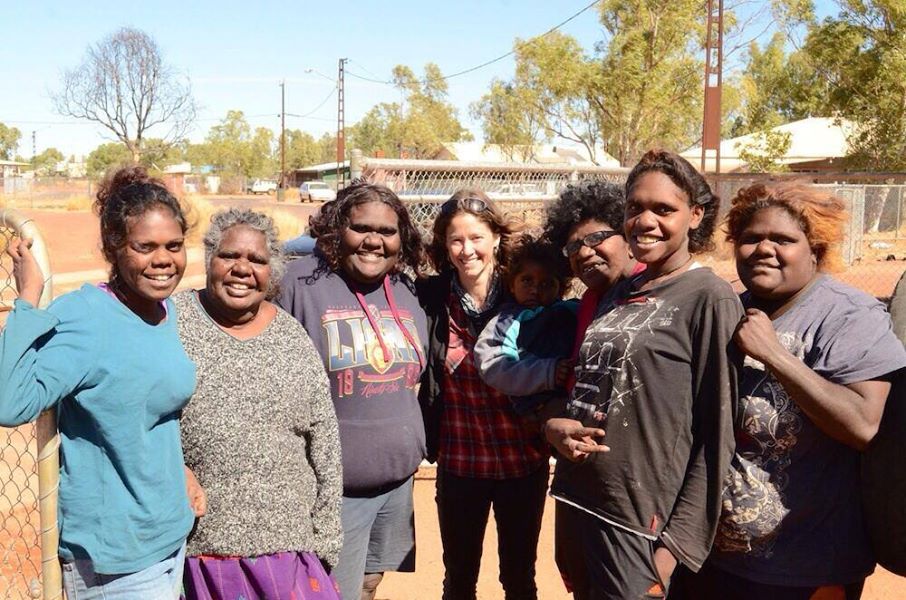
Above: Alice Springs, 19 June 2014.
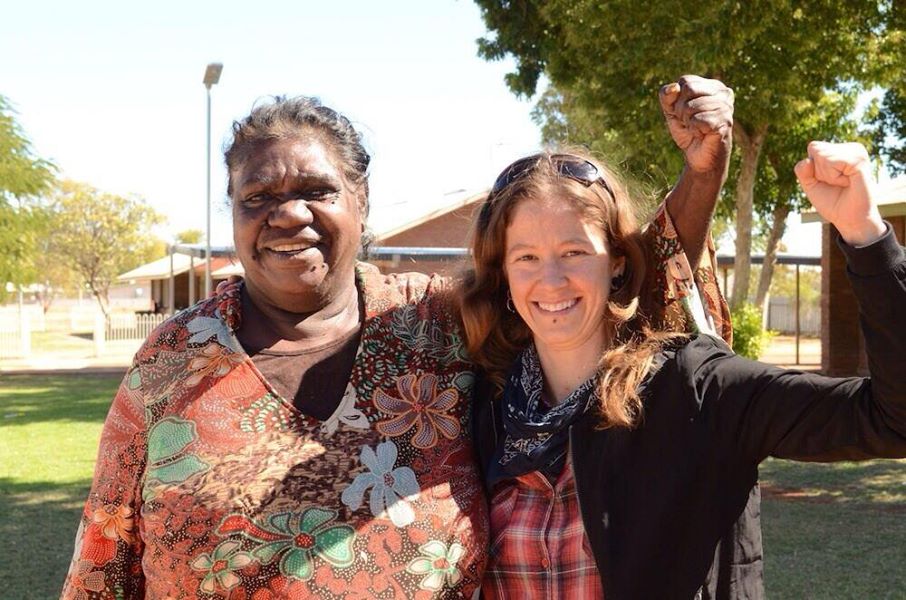
Above: Dianne Stokes and Nat Wasley
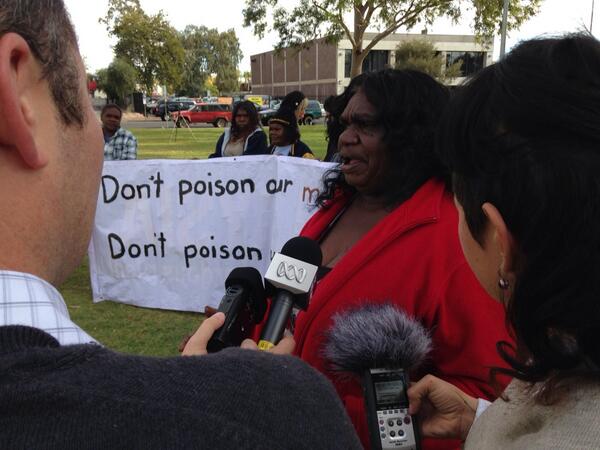
Above: Dianne Stokes: “I am proud and still in shock. We want to tell the world we stood up strong.”
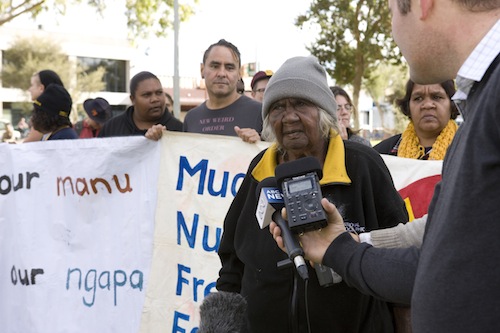
Above: Bunny Naburula: “We have fought for seven long years.”
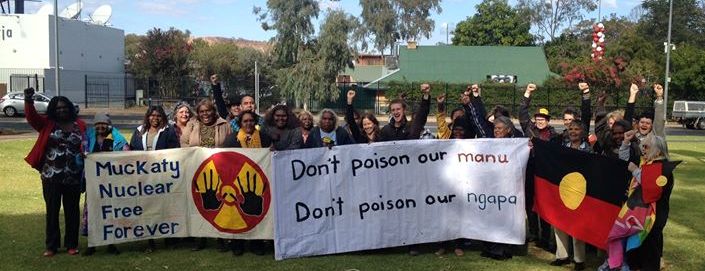
Above: 19 June 2014, Alice Springs
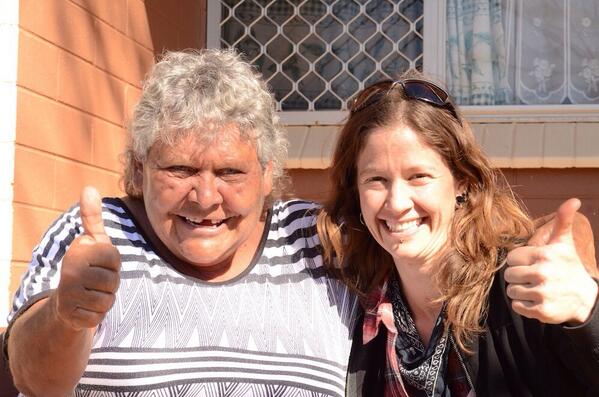
Above: Marlene Bennett and Nat Wasley, 19 June 2014.
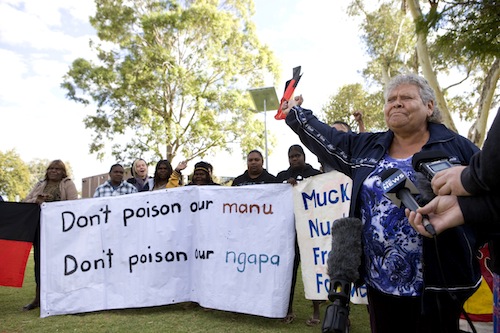
Above: Marlene Bennett: “Today will go down in the history books of Indigenous Australia on par with the Wave Hill Walk-off, Mabo and Blue Mud Bay. The Warlmanpa Nation has won an eight-year battle against the might and power of the Commonwealth Government and Northern Land Council. Justice has prevailed and this is a win for all Territorians.”
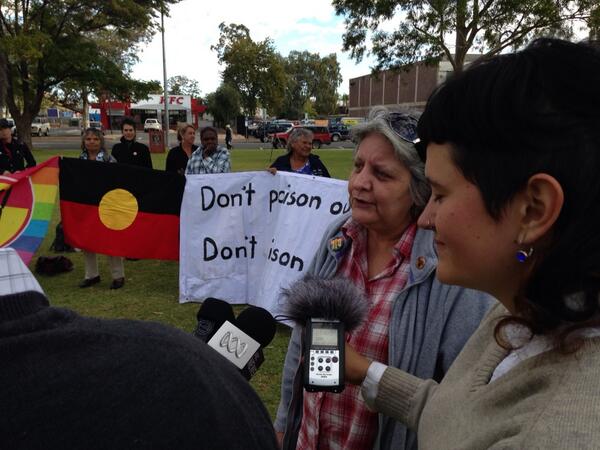
Above: Mitch: “They forgot that the women of that land were fighting for their unborn grandchildren.”
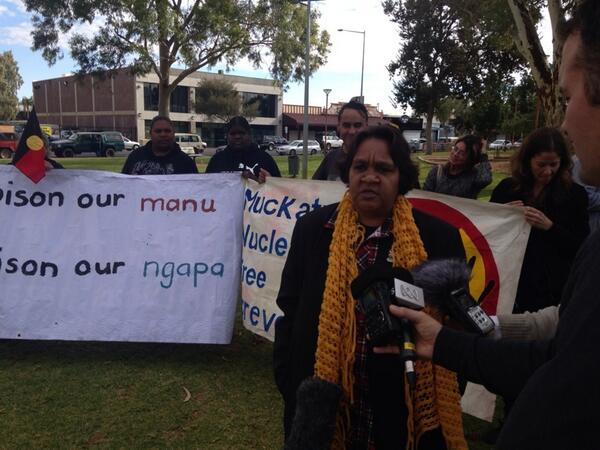
Above: Barb Shaw: “This is what happens when black and white stand together as a collective.”
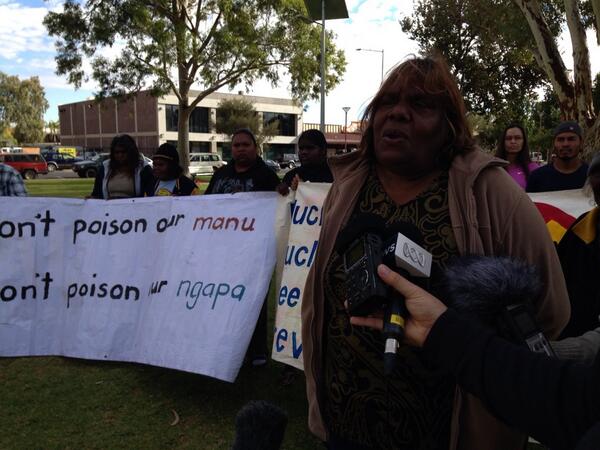
Above: Valda Shannon: “I want thank everyone who has stood with us all the way through this 8 year struggle. This has been a long an exhaustive journey. We have been silenced excluded but we kept our voices up.”
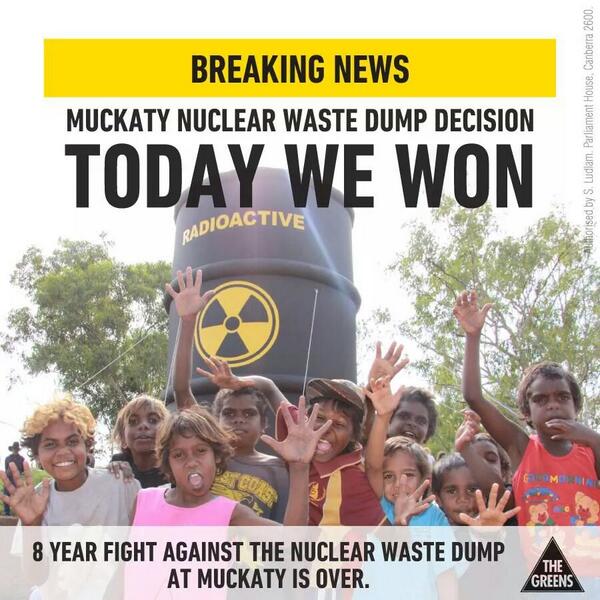
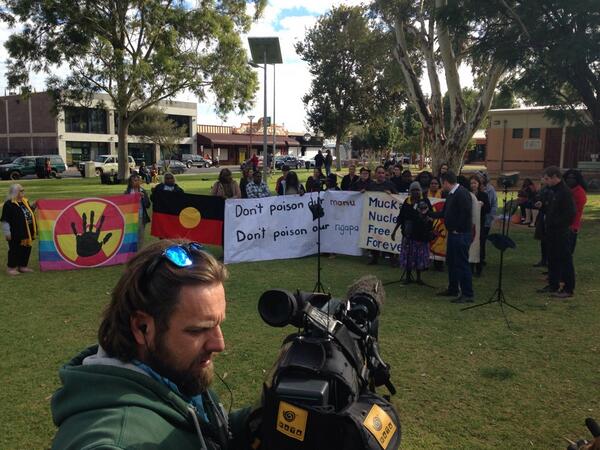
Above: Media conference in Alice Springs announcing the victory.
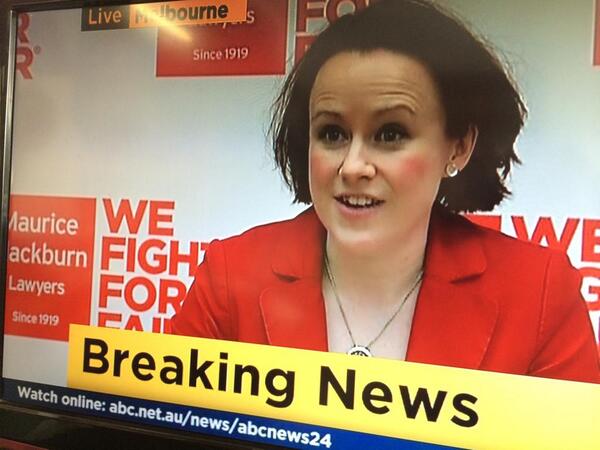
Above: Maurice Blackburn lawyer Lizzie O’Shea: “So proud to represent Traditional Owners of Muckaty Station and am thrilled the Cwth has agreed not to rely on the nomination.”
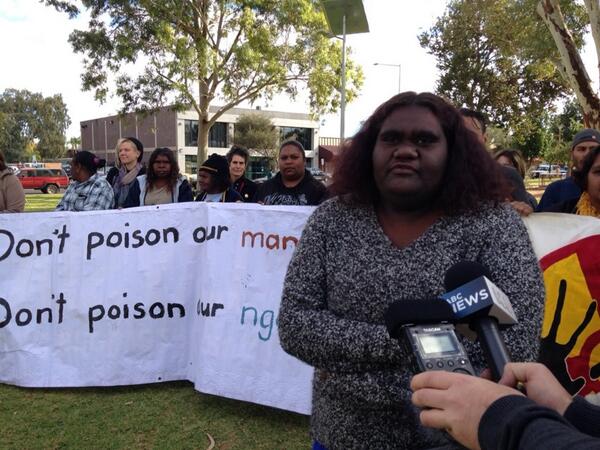
Above: Muckaty Traditional Owner and hip-hop artist Kylie Sambo. “Today we are here to tell you that we have won. My family has taught me how to fight. We are so relieved.”

Above: Adam Sharah: ‘Victory is sweet. We smashed the racist nuke industry today. Relaxing with strong women of Muckaty Land Trust.’
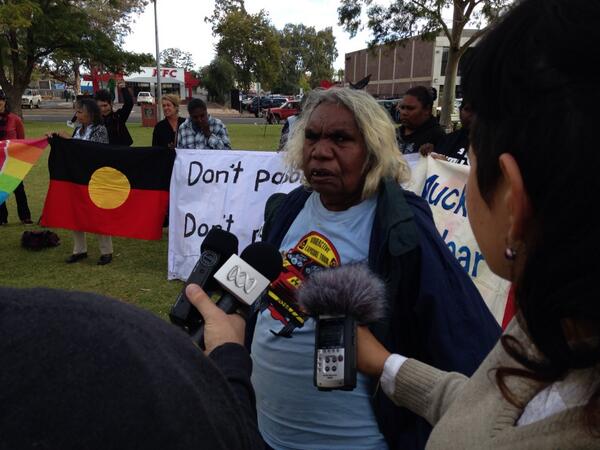
Above: Doris Kelly
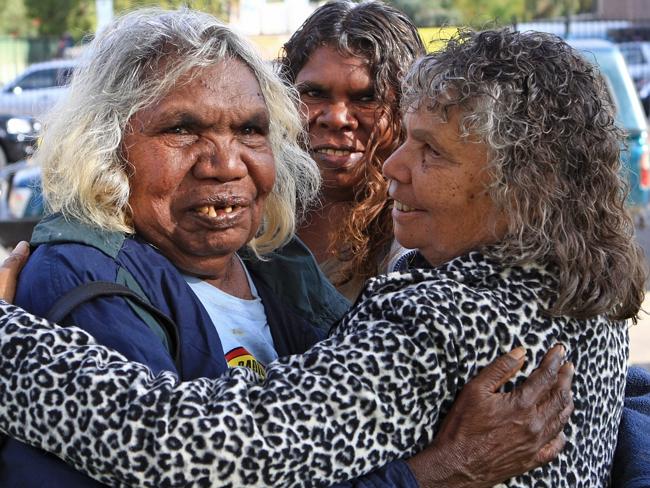
Above: Doris Kelly, Gladys Brown and Elaine Peckham
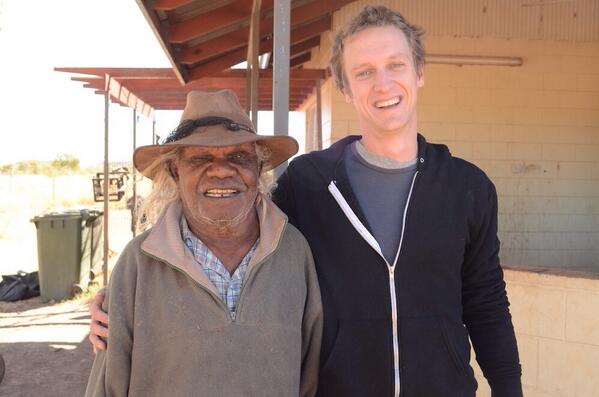
Above: Senior Warlmanpa law man Dick Foster with Paddy Gibson.
———————————————————————
‘Justice has prevailed’: Muckaty nuclear waste plan finally dumped.
Beyond Nuclear Initiative, Media Release, June 19, 2014
Traditional Owners and campaigners are celebrating today after learning that plans for a national nuclear waste dump at Muckaty in the Northern Territory have been scrapped.
The Commonwealth Government has committed to not pursue the proposed Muckaty site, the announcement coming mid-way through a federal court trial examining the site nomination process. (A federal court action lodged in 2010 began went to trial on June 2, with hearings in Melbourne and Tennant Creek. The hearing scheduled for Darwin has now been vacated.)
A delegation of Traditional Owners has travelled from Tennant Creek to speak with supporters and media in Alice Springs.
Marlene Nungarrayi Bennett, Warlmanpa woman said, “Today will go down in the history books of Indigenous Australia on par with the Wave Hill Walk-off, Mabo and Blue Mud Bay. The Warlmanpa Nation has won an eight-year battle against the might and power of the Commonwealth Government and Northern Land Council. Justice has prevailed and this is a win for all Territorians.”
Penny Williams Namikilli said “ngulayilpa wanganya ngurru-ku partta-wurru mar-darnjaku marjumarju kula yanjaku. kuyayi ngurru kirlka kan-jin-mi, mayi parnta.” [Translated from Warlmanpa: We talked about our land to keep the waste away off the land, not to put it there. We want it to remain clean with bush tucker.]
Milwayi Traditional Owner Gladys Nungarrayi Brown said, “The land is important, we have to keep it clean without radioactive waste. Our ancestors walked around that land and were always looking after it-generation after generation they kept handing that knowledge on. We have to keep passing on that knowledge to future generations.”
The Commonwealth government announced in 2005 that it would pursue three sites in the Northern Territory for a national dump, passing legislation to override NT government opposition. Amendments made in 2006 allowed additional site nominations from Aboriginal Land Councils.
The Northern Land Council offered Muckaty for assessment in 2007, despite opposition from many Traditional Owners. A determined community campaign gained support from trade unions, public health and human rights organisations around the country. Annual demonstrations in Tennant Creek pledged direct action against any attempts to build the dump.
Beyond Nuclear Initiative convenor Natalie Wasley said “Next month will mark ten years since the SA nuclear dump plan was stopped by the Kupa Piti Kungka Tjuta and supporters. Any further attempts to impose nuclear waste on Aboriginal people considered politically expendable will be defeated.”
Dianne Stokes, Milwayi kurtungurlu and Yapa Yapa kirtta said, “We will be still talking about our story in the communities up north so no one else has to go through this. We want to let the whole world know that we stood up very strong. We want to thank the supporters around the world that stood behind us and made us feel strong.”
Kylie Sambo, Milwayi Kurtungurlu and hip-hop artist said, “I joined the campaign four years ago when I wrote my hip hop song Muckaty. My sister always told me stories about our mothers dreaming, where it traveled to and from. That land means a lot to us, that’s why we stand up to protect it. My sister always encouraged me to stand up for our people and our country, my uncle and grandfather would be very happy and proud of what we have done. We are in Alice Springs with good news that we have WON the fight, If you think something is not going the right way then you stand up and speak, because if we in the centre of the Northern Territory can stand up and win then so can you.”
Court proceedings in Melbourne revealed that compensation for the radioactive dump would be in the form of roads, houses and education scholarships. This funding is desperately needed in the region, with a recent estimate that Tennant Creek alone needs around 400 houses to meet current demand.
Ms Wasley concluded, “This radioactive ransom must end. We call for the repeal of the National Radioactive Waste Management Act, which explicitly targets Aboriginal Land for a waste dump. It is time for a national commission to examine radioactive waste production and all options for management.”
———————————————————————
June 26 update from Nat Wasley – Beyond Nuclear Initiative
Dear nuclear-free friends
We received fantastic news late last week, that the Commonwealth Government has committed not to pursue plans for a national radioactive waste dump at Muckaty, 120km north of Tennant Creek in the Northern Territory!
Some more information about the last few weeks of the campaign is outlined below; please hang in there to the end as this bulletin wraps up with some ideas for connecting and contributing to Beyond Nuclear Initiative’s ongoing work.
1- The Federal Government has agreed not to act on Muckaty nomination
The announcement that Muckaty will not be pursued for a nuclear dump came mid-way through the Federal Court trial examining the process under which the nomination of Muckaty was made by the Northern Land Council and accepted by the Commonwealth Government in 2007. Lawyers from Maurice Blackburn Social Justice Practice and Ron Merkel QC were acting pro bono for Traditional Owners challenging the site nomination.
Two weeks of the trial were completed with hearings in Melbourne, Tennant Creek and on country at Muckaty outstation. The Northern Land Council and Commonwealth Government agreed on June 19 to settle with the Applicants by committing not to act on the proposal or nomination, so the hearings scheduled for Darwin (June 23-July 4) were cancelled.
The Muckaty win follows the successful campaign by the Kupi Piti Kungka Tjuta to stop a nuclear dump in SA and has been built from the ground up in Tennant Creek with help from supporters across the NT and country. Over the last 7 years, the community has marched in Tennant Creek every year, hosted trade union delegations, written songs and poems, made films and toured photo exhibitions. People have travelled tirelessly around the country to build awareness and support, having conversations over cups of tea in regional areas and walking the corridors of Canberra Parliament House to lobby Ministers.
The community used the annual May 25 rally and media attention on the federal court proceedings to reiterate they would continue campaigning until the dump was stopped- including blocking the road if needed.
Traditional Owners and the wider community in the Barkly region are very excited and relieved and looking forward to a big celebration on July 4 in Tennant Creek. Everyone is welcome to come along, contact me if you would like further details.
We will then set about collating photos, footage and other materials from the campaign, so stay tuned for the call out to copy and/or send these to the Arid Lands Environment Centre for archiving.
Federal Government is still pushing for a site on Aboriginal Land to be nominated within three months
While the Muckaty plan has been shelved, the federal government immediately starting pressuring NT Aboriginal Land Councils to nominate an alternate site within three months.
This replicates the rushed process of the first nomination that was heavily criticised during the federal court proceedings. BNI will maintain an active watch and ear to the ground on this issue. We hope that before throwing another dart at the map, the government will consider launching an independent commission that examines all facets of radioactive waste production, including options for minimisation, as well as all options for management. This call for a commission is supported by peak bodies including the Public Health Association of Australia and Australian Council of Trade Unions.
Stay in touch – and thankyou for your contribution to this long running campaign
Finally for now, we invite you to have a browse around and subscribe to the new upgraded BNI website to receive updates via a low volume email service.
I was asked by Muckaty mob to finish this note with a huge thanks to everyone who has been part of this campaign and supported the community to be heard- every action, letter, conversation, trip to Tennant, fundraising gig and movie night has helped bring about this victory!!
Thanks to your support and actions, Muckaty will be nuclear waste dump free.
———————————————————————
Muckaty: our case is like Mabo, our land is ours to protect
We’ve been fighting for eight years to stop a waste dump on our land. We brought people from different Dreamings, different clans together for this victory
Kylie Sambo
19 June 2014
http://www.theguardian.com/commentisfree/2014/jun/19/muckaty-our-case-is-like-mabo-our-land-is-ours-to-protect
Protesters against the placement of a nuclear waste dump at Muckaty Station walk to the Tennant Creek courthouse on Tuesday, June 10 2014. Photograph: AAPIMAGE
They’ve finally heard us. Tennant Creek, where my people, the Warlmanpa and Warumungu live, won’t become Australia’s first waste dump. We’ve been fighting for eight years to stop the dump, and the government did nothing about it. Finally, we had to take them to court before they understood that we were serious, that we didn’t want a waste dump in the Muckaty area.
My whole family and other extended families, the communities around the Tennant Creek region, and other people who are living there have all been supporting us these past few years, as we’ve been doing our rallies and speaking up.
They’ve come on board and joined us, marched with us in Tennant Creek. This year has been a very good outcome. A lot of people from different Dreamings, different family groups, different clans have come together in our struggle. I believe this is an impressive way to show we stick together, we fight together.
I was worried a bit that the case would go the other way. My sister kept saying, “We’re going to win this one, we’re going to win this one!” My mind was set that the decision was going to be made in March next year. When I got the news, I was shocked that we won. I’ll travel back to Tennant Creek and celebrate this weekend. I’ll probably celebrate all week.
I believe that our case is similar to the Mabo case, and the legal struggles other communities have been fighting against the government for years to protect their land. That’s what we’re doing.
How many times has the government seen people fighting for their country, and yet they keep doing this. They have to understand us: our land means a lot to Aboriginal people because it’s ours, because it’s ours to protect.
———————————————————————
Muckaty station nuclear waste dump will not go ahead: Aboriginal Traditional Owners succeed in legal challenge
Maurice Blackburn statement, 19 June 2014
http://www.mauriceblackburn.com.au/about/media-centre/media-statements/2014/muckaty-station-nuclear-waste-dump-will-not-go-ahead-aboriginal-traditional-owners-succeed-in-legal-challenge/
Plans to build a nuclear waste dump on Aboriginal land at Muckaty Station near Tennant Creek will not go ahead after the Commonwealth agreed not to act upon the nomination of the site by the Northern Land Council (NLC).
Leading social justice law firm Maurice Blackburn has been acting for Traditional Owners opposed to the dump in a four-year legal fight that was two weeks into a Federal Court trial when it was resolved.
The parties plan to ask that Justice Anthony North of the Federal Court dismiss the proceedings, which were due to continue in Darwin next week. This settlement is without any admission of liability.
Elizabeth O’Shea, head of Maurice Blackburn’s social justice practice said:
“Aboriginal people at Muckaty have been fighting this plan for more than seven years and are overjoyed to have secured this outcome.
“We are thrilled to share in the relief and excitement our clients are feeling, knowing that their country will not be the site of the country’s first nuclear waste dump.”
The matter has been run by Maurice Blackburn on a pro bono basis. Barristers including Ron Merkel QC and David Yarrow have also acted pro bono.
“Just like the class actions and other landmark cases brought by Maurice Blackburn, our pro bono cases provide access to justice and make a real difference in terms of public accountability”, Ms O’Shea said.
Lorna Fejo, a Traditional Owner said:
“I feel ecstatic. I feel free because it was a long struggle to protect my land. I feel really happy about this decision because my children, grandchildren and great grandchildren can go to Namerini safely. This is what Australia is: it is a free land and Traditional Owners must always be free to express what they want done on their land.
“My grandmother gave me that land in perfect condition and other lands to my two brothers, who are now deceased. It was our duty to protect that land and water because it was a gift from my grandmother to me. And now that I am 84 years old, and I have had to fight hard to protect this land for my grandchildren and great grandchildren, it is now a gift which I will be able to pass onto them in its perfect condition, like I had received it.”
LEGAL BACKGROUND
A fee simple estate in Muckaty Station was granted to the Muckaty Aboriginal Land Trust (MLT, a respondent to the proceeding) in 1999 following a claim under the Aboriginal Land Rights (Northern Territory) Act 1976 (Cth) (ALRA). The MLT holds Muckaty Station on trust under the ALRA for the benefit of the traditional Aboriginal owners of Muckaty Station and of other Aboriginal persons entitled to enter upon or use the land in accordance with Aboriginal tradition.
The Northern Land Council (NLC, also a respondent) is a body established under ALRA to supervise and administer Aboriginal land trusts in respect of areas in the Northern Territory including Muckaty Station. The NLC is responsible under ALRA for giving lawful directions to and acting on behalf of the MLT for the benefit of the traditional Aboriginal owners of and the Aboriginal people holding an interest in Muckaty Station.
In June 2007, the NLC purported to nominate a portion of Muckaty Station as a potential site for the management and storage of radioactive waste.
Traditional Owners alleged in the action that the NLC failed to take appropriate steps to ensure the traditional Aboriginal owners understood the nature and purpose of the nomination, and failed to obtain proper consent before nominating the site.
Legal proceedings against the Commonwealth and the NLC were commenced in June 2010. The Federal Court trial began on 2 June 2014.
———————————————————————
Activists win seven-year fight to protect Muckaty, minister still seeks dump site
Saturday, June 21, 2014
By Mara Bonacci, Alice Springs
https://www.greenleft.org.au/node/56681
When Muckaty traditional owners first heard about a proposed waste dump on their land seven years ago, it didn’t seem like such a bad idea. Many thought it was a general rubbish tip that would recycle, sell reclaimed materials and provide work opportunities for people living in the remote area of the Northern Territory. Millions of dollars were promised for roads and scholarships. In an area with few employment prospects or education opportunities, it is little wonder the offer seemed attractive.
Then came the truth. The proposal was not for a tip, but for radioactive waste. The money would not go straight to traditional owners, but to the Northern Land Council (NLC) to be held in a charitable trust. It seemed there was more to the proposal than met the eye.
This month, a seven-year grassroots campaign against the dump and a four-year federal court challenge against the federal government and the NLC came to an end when the NLC withdrew its nomination of the Muckaty site. That eliminated the need for their officials to take the stand at court in Darwin after evidence was heard from traditional owners in Tennant Creek.
The first that Warlmanpa traditional owner Marlene Nungarrayi Bennett heard about the dump proposal was on the radio. One of the witnesses questioned in court at Tennant Creek, she told of her surprise at first hearing about it on the radio and how she set about educating herself, her family and community about the proposal. Once she learned the truth about the potential impacts of a radioactive waste dump, she was firmly opposed to it going ahead.
Traditional owner Dianne Stokes, who has been a staunch and tireless campaigner against the dump since it was nominated by the NLC in 2007, was also initially in favour of it because of the benefits it would supposedly bring to the community.
It was not until Beyond Nuclear Initiative (BNI) campaigners came to Tennant Creek and explained what the waste would be, how far it had to be transported to get there and the risks associated with it, that she realised it was not a proposal she could support.
In a statement she said: “We will be still talking about our story in the communities up north so no one else has to go through this. We want to let the whole world know that we stood up very strong. We want to thank the supporters around the world that stood behind us and made us feel strong.”
With the support of BNI, over the past seven years, the community has marched in Tennant Creek annually, hosted trade union delegations, written songs and poems, made films and toured photo exhibitions.
People have travelled tirelessly around the country to build awareness and support, having conversations in regional areas and lobbying ministers at Parliament House in Canberra. Supporters have held fundraisers and information nights around Australia.
Kylie Sambo, Milwayi Kurtungurlu and hip-hop artist, said: “I joined the campaign four years ago when I wrote my hip-hop song ‘Muckaty’. My sister always told me stories about our mothers dreaming, where it travelled to and from.
“That land means a lot to us, that’s why we stand up to protect it. My sister always encouraged me to stand up for our people and our country, my uncle and grandfather would be very happy and proud of what we have done.
“We are in Alice Springs with good news that we have won the fight. If you think something is not going the right way then you stand up and speak, because if we in the centre of the Northern Territory can stand up and win then so can you.”
The remote area where the dump was proposed may seem to the government, industry and city-dwellers to be a safe and reasonable place to dump radioactive waste. It has, however, a vibrant community, strong Aboriginal culture and many people call it home. Radioactive waste is not something anyone wants next door. This is possibly part of the reason the government wants to relocate the waste from where it is now stored at Lucas Heights in southern Sydney.
A successful campaign by the Kupi Piti Kungka Tjuta to stop a nuclear dump in South Australia 10 years ago led the federal government to push for a dump in the Northern Territory. The risk remains that a dump may be proposed elsewhere in Australia.
Although the federal government has withdrawn its push for a radioactive waste facility at Muckaty, Minister for Indigenous Affairs Nigel Scullion said: “I would hope it [the end of court action] would offer opportunities for a second nomination of a northern site.”
The people of Muckaty and anti-nuclear activists say: “Not here, not anywhere.” This people-powered fight will continue if another site is nominated.
[Mara Bonacci is an anti-nuclear campaigner based in Alice Springs.]
———————————————————————
Parliamentary speech by Greens Senator Scott Ludlam
http://scott-ludlam.greensmps.org.au/content/speeches-parliament/muckaty-congratulations-speech-parliament
Senator LUDLAM (Western Australia): Tonight, I want to pay my respects to the Aboriginal elders of the Muckaty lands in the Barkly region, their families and their supporters around the country. I understand that only a tiny handful of MPs in this place could even find Muckaty on a map and bear no knowledge of the rich history of the place. For white politicians on the other side of the continent, the Barkly region is essentially regarded as the absolute middle of nowhere. There is nowhere better to park Australia’s 60-year inventory of spent nuclear fuel, which is industrial waste that will still be carcinogenic a thousand generations from now, decaying silently away into future geological ages. Everything it touches, for all those future lifetimes of people who will never know our names, becomes not just contaminated but contaminating.
Every country that embarked on the nuclear experiment that lit up the mid-20th century with the light of a thousand suns has its own millennial legacy of spent nuclear fuel and reprocessing wastes. No country has come up with a solution that will keep it isolated for tens of thousands of years. Presently, nearly all of Australia’s radioactive waste is banked adjacent to the Lucas Heights reactor on the outskirts of Sydney. A small amount of it is contracted to return to Australia from Europe next year. This impending shipment was the trigger for the process that came to a dramatic end in the federal court in Melbourne last week.
Late in 2005, the Howard government used its command of the numbers in both houses of parliament to ram through a bill mandating that Australia’s radioactive waste would be trucked into the Northern Territory and dumped at one of three possible defence department sites-in other words, on land stolen from people who had been living and singing that country since before the last ice age. The Greens opposed this bill. The Democrats opposed it. The Labor Party stridently opposed it. But numbers matter in here and, on that night, we didn’t have them.
I want to acknowledge the communities of people who spoke up for each of those three sites, the pressure and uncertainty placed on you, the stress on your families, and the leadership you showed in stepping up and saying no. All of you were unfairly targeted in a process with no procedural, scientific or democratic legitimacy.
Within a year, the fatal flaws in this bankrupt proposal were evident even to senior members of the Howard government. An amendment bill was pushed through here late in 2006 to add an illusion of due process to this amoral preamble: communities can now volunteer a site for the dump. Only sites in the Northern Territory, constitutionally weaker than the states, would be considered. Within what seemed like mere hours, a site was nominated by the Northern Land Council, and this place, Muckaty, which no whitefella outside the Barkly Region had ever heard of, was suddenly at the top of the Commonwealth government’s target list. The cause and effect, and who really originated the Muckaty nomination, we will probably never know. But we do know that, from day one, this was a process driven from Canberra, not Tennant Creek.
Fourteen years earlier, the High Court had struck down the offensive legal fiction of terra nullius; but, even so, when government bureaucrats and politicians with more immediate things on their minds go looking for somewhere to dump the nation’s most poisonous garbage, they go looking for empty lands, places in the middle of nowhere, places like Muckaty Station. And when they climb out of their shiny land cruisers, they discover that it is not empty at all. They discover it is a real place, not just a rectangle on their GPS-a place with a history and a story that proceeds history and many stories told in languages they will never bother to learn. Imagine their surprise to discover that this terra nullius is inhabited-inhabited by the formidable Dianne Stokes and her family, by Bunny Ngaparula, an elder who somehow seems to get younger every year, and by the deadly Kylie Sambo. They are confronted by Mark Lane Jangala and Ronald Brown and by Lorna Fejo and Dick Foster. They are challenged by mighty allies from further afield-Mitch from Arrende country and Donna Jackson from the Larrakia nation, and many, many others. Collectively, these unwelcome strangers are told to pack up their cars, their fancy maps and their 100,000-year-contamination nightmare and go the hell home.
If you are going to be thrown into a campaign like this without warning, you are going to need allies. Profound respect to Nat Wasley, her partner Paddy and up and coming anti-nuclear campaigner, Jalinyba. Natty, you are one of the most kickass organisers I have ever had the honour to work with. There is my dear friend Dave Sweeney, who has long been the backbone of the Australian Conservation Foundation’s anti-nuclear work and is the author of the best one-liners in the business. There is also Jim Green from Friends of the Earth in Melbourne, one of the country’s most dedicated and tenacious campaigners. There are so many others, but to name just a few: Cat Beaton and Lauren Mellor, Hillary Tyler and Justin Tutty, you stepped up when the old people needed your help. Ellie Gilbert and Peter Sutton, Leanne Minshull and Michael Fonda, you saw the need and did not look away. There is Jagath Dheera-Sekara, Rod Lucas and everyone at the Jumbunna Indigenous House of Learning, and dear Dimity Hawkins. My Western Australian Anti-Nuclear family – Jo Vallentine and the staunch BUMP crew – just one powerful piece of a national campaign that finally delivered. And then there is everyone at the Arid Lands Environment Centre and the Environment Centre Northern Territory, FoE Melbourne and ACE campaigners – nearly all of them volunteers. For every demonstration, every banner drop, every early morning occupation of Martin Ferguson’s electorate office, it has all been worth it.
There is Felicity Ruby, who worked with me for years. As we discovered, after the 2007 election, those Labor politicians who had been so staunch from opposition, turned silent when they actually had a chance to do something about Muckaty from government. They maintained their silence as Minister Martin Ferguson took this piece of procedural abuse designed by Prime Minister John Howard and then stepped up the aggression. We held off the Rudd government’s waste dump legislation for two years. But in 2012 the Labor Party took legislative responsibility for driving this obscene theft of country over the raised voices of traditional owners and their supporters-and we will not forget this.
The appalling behaviour of the Labor Party in sliding seamlessly from condemnation to continuity makes recognition of the handful of ALP members who did buck the party line that much more important. I particularly want to acknowledge local MPs Gerry McCarthy and Elliott Macadam, backed by NT Chief Minister Paul Henderson; and, federally, Senator Louise Pratt, who tragically had to give her valedictory speech earlier this evening; Melissa Parke, the member for Fremantle; and, more recently, Senator Nova Peris, who brings heart and history to her opposition to this project. The rest of the Labor caucus stand condemned by your silence and by the votes you cast when you finally combined with the Abbott opposition to defeat the Greens in March 2012.
I also want to acknowledge those in the trade union movement who stood up when it mattered, particularly the ACTU and Unions NT, and also the MUA, the ETU and the Fireys, representing those first on the scene when things go horribly wrong at facilities like this. The failure of parliament to uphold its obligations to the mob, yet again, left it to the community movement and to a small but focused legal team as the last line of defence. George Newhouse, Mark Cowan, Steven Lennard and David Yarrow, thanks are owed for your generosity and your expertise. Ron Merckel QC, Julian Burnside QC and the brilliant Lizzie O’Shea, lawyer to the people-last week, you did it, and broke the Commonwealth government’s resolve in the Federal Court and brought this shameful episode to an end. As a quick aside, you could have followed and supported this whole extraordinary contest if you were listening to the radioactive show on radio 3CR. Thank goodness for the community broadcasters.
There is a reason why the nuclear industry seeks high isolation sites for its proposed waste dumps: stable geology, deep groundwater, low seismic activity, no people, no mineral resources. Muckaty actually meets none of these preconditions, but put that down to a jittery government running before an artificial deadline. The reason the industry likes these remote, high isolation sites is that there is no form of engineered barrier that can contain spent nuclear fuel for such immense periods of time. They know this material will burn its way out eventually, and so they want to put it as far from the suburbs in which they live as possible.
What the mob in the Barkly want to know is, if it is too dangerous to leave where it is, guarded by a Federal Police detail and ticking away under 24/7 monitoring by technicians with lab coats and PhDs, how does dumping it in a shed surrounded by a chain-link fence on a cattle station somehow make it safe?
The campaign to support Dianne and the Muckaty mob was born out of this dismal injustice; racism, with a 25,000-year half-life. The NLC negotiated for $12 million for the 300-year head lease. It works out at a little bit over $800 a week, with the land passing back to the mob sometime in the 24th century. Beads and blankets, not laced with smallpox but with caesium.
We must never do this to an Australian community again. The Muckaty mob won this time, but it cost them, in stress to families, division in the community and time away from home. The Kunkas in South Australia had to go through this trauma a decade earlier. They won too. The mob at Cosmo Newberry were in the firing line when Pangea came calling in 1999 with a proposal to dump 20 per cent of the world’s spent nuclear fuel. It took us a year to beat that. The Navajo prevailed over a similar project at Yucca Mountain in Nevada in the United States. What do all these projects have in common? The expectation that it is aboriginal communities that should bear the burden. This has to stop.
The Greens propose a new way forward. Its most important element is that it does not assume, as a foregone conclusion, that it should fall to some remote Aboriginal community to take responsibility for this poisonous time capsule. In fact, the most important thing we could do now would be to admit that there is no scientific or community consensus that a remote shed surrounded by barbed wire is anything like an appropriate management strategy for this material. It is time, as Dave Sweeney would put it, for a process, not a postcode.
We propose therefore an independent commission on radioactive waste management to run an open, deliberative process that acknowledges, as a starting condition, that if material is dangerous in Sutherland Shire, it will still be dangerous in the Barkly. It is time to leave the politics outside the room and bring together the best minds in the country, learning from 60 years of overseas experience, to design a long-term strategy of custodianship and eventually, perhaps, isolation of radioactive waste. It will confront us with the question of whether we should be producing this material at all.
Yes, it has to go somewhere. Maybe it ends up in Synroc bricks. Maybe it ends up two miles below the surface. Maybe it stays right where it is while smarter people than us work out how to contain it for periods approaching eternity. But, as we have been saying for nearly eight years, it will not be going to Muckaty. You mob were too deadly. You beat them. Take a rest and tell your story, and maybe this time a few more people will be listening.
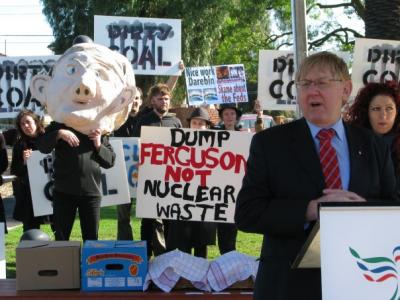
Above and below – Former Labor MP Martin Ferguson drove legislation through parliament permitting the imposition of a dump with no Aboriginal consultation or consent. Mr Ferguson ignored countless requests for meetings with Muckaty Traditional Owners.

———————————————————————
Muckaty Mob Win Battle To Stop Nuclear Dumping Ground
By Chris Graham, 19 Jun 2014
https://newmatilda.com//2014/06/19/muckaty-mob-win-battle-stop-nuclear-dumping-ground
The Warlmanpa people of Central Australia are this morning celebrating a sensational legal victory over government plans to dump nuclear waste on their land. Chris Graham reports.
The ‘Mob from Muckaty Station’ have scored a stunning victory over attempts by the Northern Land Council and the Commonwealth Government to dump nuclear waste on their land.
In what was shaping up as a true ‘David vs Goliath battle’, the Commonwealth this week pulled out of ongoing litigation over plans to build a nuclear waste dump on the land of the Warlmanpa people, north of Tennant Creek in Central Australia.
And the fall out is going to be huge, particularly for the Northern Land Council (NLC).
For the last seven years, the NLC has been maintaining it obtained the proper consent of Traditional Owners of land at Muckaty Station to build the Commonwealth waste dump.
But the Warlmanpa people – who have an interest in the land – say they were never properly consulted, and never gave their agreement.
They challenged the NLC’s claims around consent in the Federal Court, which is already two weeks into hearings. The case was set to re-convene in Darwin on Monday, and run for at least another two weeks.
But last night, the Warlmanpa people received confirmation the Commonwealth had guaranteed it would not rely on the consent nominations provided by the NLC.
The withdrawal comes just days before Northern Land Council officials were due to take the stand to face the same sort of intense grilling senior Warlmanpa custodians had been subjected to by NLC lawyers in Tennant Creek last week.
The shock withdrawal has fuelled speculation the NLC was seeking to avoid damaging scrutiny of its handling of the nomination process.
Ron Merkel QC, for the Warlmanpa people, had already told the Federal Court that an anthropology report which underpinned the waste dump nomination – and which had been changed significantly – should be considered to have been written by the NLC’s principal lawyer, Ron Levy.
Paddy Gibson, a researcher with the Jumbunna Indigenous House of Learning at the University of Technology, Sydney has been working with the Warlmanpa people since the dump was first announced.
“The Warlmanpa people who opposed the dump had been subjected to a fierce cross examination by NLC barristers, who were trying to denigrate their cultural knowledge,” Gibson told New Matilda.
“But the Traditional Owners have held the line, and they’ve insisted all along that the anthropology report underpinning the nomination was wrong, and that the process that the NLC used was completely inadequate.
“People said in their evidence that they felt intimidated and shut out of the process.
“The NLC are refusing to admit wrongdoing as part of this deal. However, by avoiding the Darwin court hearings I firmly believed they’ve dodged a bullet.”
By withdrawing, the Federal Court made no determination on the matter, and the NLC and Commonwealth also avoided having both a judgment and costs awarded against them.
“Today in a Darwin press conference, NLC CEO Joe Morrison said that he did not want anymore Traditional Owners to be subjected to the fierce cross examination that took place in Tennant Creek,” Gibson said.
“It was an NLC barrister who did that. It was an NLC barrister who attempted to denigrate the cultural knowledge of senior Warlmapna people for three hours in these cross examination sessions.”
For their part, the Warlmanpa people are celebrating. Kylie Sambo, a young Warlmanpa leader told New Matilda this morning her people were relieved the matter was finally over.
“I feel relieved that we don’t have to keep going. We’re happy and we’re proud. That land means a lot to us because of our culture, our beliefs and our totems and dreaming that went through there,” Sambo said.
“I believe [the NLC] didn’t want to go through that humiliation of what they really done. But it’s better now that they actually backed off. It’s good for us.”
But Sambo said her people weren’t quite done fighting yet. They’re now turning their attention to getting the Northern Territory land council boundaries shifted, so they no longer come under the jurisdiction of the NLC.
“Hopefully we can continue to try and push the boundary for the NLC back up north a bit.
“We had a good trust there but then they broke it. It’s going to be tough, we stood and fought for eight long years and I think we can take on anything now.”
The Warlmanpa are also considering a push by Traditional Owners for the Commonwealth to honour an agreement reached as part of the process which would provide education benefits in exchange for land.
It emerged during proceedings that the federal Department of Education had been involved in negotiations with Traditional Owners to provide $1 million in scholarships for local children, if they agreed to make their land available for the waste dump.
“I think that is very, very stupid idea for us to sell our land to get better education and scholarships,” Sambo said.
“As an Australian we should be already entitled to that.”
The Commonwealth Government will now have to look elsewhere for somewhere to dump their nuclear waste, after also earlier losing a battle with the South Australian Government.
———————————————————————
Lauren Mellor (ECNT), 20/6/14:
Bob Gosford: the conduct of the NLC has been an absolute disgrace over 8 long bitter years in which they made no attempt to reconcile, settle or include the majority of muckaty traditional owners in discussions on this highly divisive and contested project. Easy to scapegoat so-called ‘out-side interests’ as interfering, perhaps you missed the years of public outreach events led by Muckaty mob opposed to the dump calling for support to have this nomination overturned? The NLC has played an even more divisive role than the federal government amongst the community to try and push through its dodgy nomination, and senior staff that facilitated this nomination would have been raked over the coals in court next week if they hadn’t offered to settle. The hearings in Tennant clearly proved NLC did not gather the correct evidence on which to nominate muckaty – court next week would have proved that that was a deliberate act. There’s not a scrap of credibility left to cling to for either gov or NLC over this long running debacle – a sad missed opportunity to reform a thoroughly rotten organisation by Joe Morrison.
———————————————————————
Maritime Union of Australia:
Dumped! National Radioactive Waste Won’t Be Disposed Of At Muckaty
June 19, 2014
http://www.mua.org.au/dumped_national_radioactive_waste_won_t_be_disposed_of_at_muckaty
After a long campaign by traditional owners, unions and progressive organisations across the country, the Commonwealth Government has committed not to pursue plans for a national radioactive waste dump at Muckaty, 120km north of Tennant Creek in the Northern Territory.
The campaign to oppose the dump began in 2005, with strong support and involvement of the MUA.
Upon hearing the news, Assistant National Secretary Ian Bray dispatched the following message to traditional owners:
“Dear Muckaty Traditional Owners,
On behalf of the Maritime Union of Australia I want to warmly congratulate you on your historic victory to protect your land from radioactive waste.
When the Commonwealth Government first announced plans to use Muckaty lands as a dump for nuclear waste, it was simply assumed by most that it was an inevitability – a done deal.
Yet your spirit, smarts and sheer tenacity have resulted in a great Australian victory for the underdog.
I know that Muckaty Traditional Owners – and many others who supported your cause – have travelled tirelessly across the country to build awareness and support.
I know that behind the scenes many have worked diligently on organising continual letters, rallies, meetings, community conversations, trips to Tennant Creek, fundraising gigs, and movie nights.
What a magnificent thing it is that all this effort has finally paid off handsomely.
MUA members are often required to move radioactive waste, so it is an issue that resonated strongly with our members from the start.
We are proud to have stood with you in your fight and we are overjoyed that you have been successful.
I am certain that the bonds we have forged during this long struggle will remain strong for many, many years to come.
Your great victory is an inspiration to all of us who fight for justice in the face of overwhelming power.
I hope you celebrate long and hard – you truly deserve it.
Yours sincerely,
Ian Bray
MUA Assistant National Secretary
———————————————————————
The Northern Land Council has played a disgraceful role, selling out Traditional Owners. To give just one example − of many − the NLC supported legislation by John Howard and Martin Ferguson that allows the imposition of a nuclear waste dump on Aboriginal land with no Aboriginal consultation of consent. Below is an asinine, self-serving statement from the NLC and see also an even worse NLC statement at this link.
http://blogs.crikey.com.au/northern/2014/06/19/northern-land-council-settles-muckaty-claim/
———————————————————————
NLC settles on Muckaty
http://www.nlc.org.au/media-releases/article/nlc-settles-on-muckaty/
June 19, 2014
NLC CEO Joe Morrison addresses the media today.
OUT of concern for relations among the Aboriginal clans which comprise the Muckaty Aboriginal Land Trust, the Northern Land Council has agreed to settle the Federal Court challenge to the Commonwealth Government’s proposal to establish a nuclear waste facility at Muckaty.
The settlement, offered by the lawyers representing opponents of the facility, was signed off by the parties in Melbourne late yesterday.
In June 2007, the NLC nominated a site for the facility on 225 hectares in the south-east section of the Muckaty Aboriginal Land Trust area. The Commonwealth approved the site in September 2007.
“The NLC notes that its acceptance of the offer is done without any admission of liability – that is, without any admission that the nomination was made in error,” said NLC Chief Executive Officer Joe Morrison.
Mr Morrison said the NLC remains satisfied that it made the nomination with the consent of traditional owners and after consultation with other Aboriginal people with interests in the land.
“In fact, the applicants’ own evidence, heard in Tennant Creek last week, acknowledged that the NLC had consulted broadly and appropriately, with the involvement of all affected groups, and that consent was given to the nomination in accordance with Aboriginal tradition,” he said.
“The NLC maintains that the nomination was not affected by any relevant error and that the legal challenge would have failed.
“However, it is apparent for various reasons – largely due to outside pressures, including pressures caused by divisive litigation – that a number of individuals have shifted their position since the nomination and no longer want the facility to be constructed on the nominated land.
“Because of the divisions within the Aboriginal community, the NLC is now of the view that it would be preferable if the Commonwealth did not act on the nomination. The Commonwealth has agreed with our proposition.
“This position has, of course, been endorsed by the NLC’s Executive Council, which now wants to help the restoration of good relations among the Muckaty families.”
———————————————————————
Muckaty radioactive waste dump plan dumped
ACF Media Release, 19 June 2014
http://www.acfonline.org.au/news-media/media-release/muckaty-radioactive-waste-dump-plan-dumped
The Federal Government’s decision to end the plan for a national radioactive waste dump at Muckaty, north of Tennant Creek in the NT, is a win for Traditional Owners, the environment and responsible radioactive waste management in Australia, the Australian Conservation Foundation said today.
The Federal Government today committed not to act on the Northern Land Council’s contested nomination of Muckaty as the site for a national radioactive waste dump. The decision comes during a Federal Court hearing initiated by Traditional Owners opposed to the dump plan and conducted on a pro bono basis by law firm Maurice Blackburn.
“Muckaty was always a bad deal – it is a profound relief it will now never be a done deal,” said ACF nuclear free campaigner Dave Sweeney.
“This result is a tribute to the tenacity and courage of the many Traditional Owners who have been tireless in their defence of country and culture for more than seven years.
“It is also a stark reminder of the failure of successive federal governments to adopt an effective and responsible approach to radioactive waste management and highlights the need for a new approach to this old problem.
“After decades of division and secrecy it is time to do things differently and better. Instead of searching for a vulnerable postcode for a dump it is now time to advance a credible process for management of radioactive waste,” he said.
ACF and other civil society groups, including the ACTU and the Public Health Association, have long called for an independent, expert and public national commission to explore options for responsible radioactive waste management in Australia.
“Muckaty is the latest in a series of failed attempts to impose a dump on unwilling communities in both South Australia and the NT,” Dave Sweeney said. “It was a secretive and ill-considered deal that has properly failed the test.
“We can all be pleased this proposal is finished, but no other Australian community should have to face the pressure and heartache the Muckaty community has experienced.
“It is time to stop the flawed and failed search for a short term political fix and instead adopt an open, evidence-based approach on how to manage a long term human and environmental health hazard.”
———————————————————————
Muckaty nuclear dump defeat is a huge victory for Aboriginal Australia
Elizabeth O’Shea (Maurice Blackburn lawyer)
19 June 2014
http://www.theguardian.com/commentisfree/2014/jun/19/muckaty-nuclear-dump-defeat-is-a-huge-victory-for-aboriginal-australia
Today, the Commonwealth Government has agreed not to act upon the nomination of land at Muckaty Station as a site for Australia’s first radioactive waste dump. The resolution comes seven years after the nomination, four years after the court case was started, and two weeks into a seven week trial. The matter has settled with no admission of liability. Maurice Blackburn’s social justice practice conducted this case on a pro bono basis, and we couldn’t be prouder of the outcome or happier for our clients.
Muckaty Station, 110km north of Tennant Creek, is an Aboriginal land trust under the Aboriginal land rights act. In the 1990s, the Aboriginal land commissioner, justice Gray, was tasked with working out who were the traditional owners of that particular country and the nature of land tenure under customary law. He wrote a report and handed the land back to Aboriginal people on the basis of his findings.
This means the land is owned outright by Aboriginal people, like most people own their homes. Under the law, the land is dealt with according to customary law or agreed processes. The idea is that Aboriginal people are in charge of their land, with the Northern Land Council (NLC) acting on their behalf. It is a statutory scheme that now seems quite visionary, especially in relation to the small minded attitudes that underpinned the Intervention and its successor, the Stronger Futures regime.
Understandably, the return of land to Aboriginal people is a source of immense pride for many. Aboriginal people treat their customary obligations seriously and with dignity, undercutting many of the old lines about Aboriginal people from the reactionary songbook.
In relation to Muckaty, there may be many Aboriginal people who have an interest in the land under customary law. The NLC is charged with dealing with land according to certain rules. They have legal duties to obtain informed consent from people who have primary spiritual responsibility for country, but also to give those with an interest in the land the opportunity to express their views.
In 2005, the Howard government introduced legislation to facilitate the building of Australia’s first radioactive waste dump. The Commonwealth had sites that it owned already and could use, but the NLC lobbied to introduce a provision which permitted Aboriginal people to volunteer a site.
In 2006, the NLC began negotiations with the Commonwealth about a nomination of a site on the Muckaty land trust. The proposed nomination was immediately contentious. Eventually, the Commonwealth offered $12m in the event that the nomination was declared to be the site of the dump. The NLC say they obtained consent and consulted with the right people. The deal was signed in 2007.
There is no doubt that some traditional owners consented to the nomination. It is easy to see why – these are some of the poorest people in Australia and this is a lot of money, though it starts to look quite miserly when compared with international examples.
However, there are five key dreamings on Muckaty that are relevant to this site. The NLC’s stated position was that one sub-branch of one dreaming group were exclusively able to consent to the nomination. Representatives of every other dreaming oppose the dump.
This contrasts with justice Gray’s report, which clearly articulates how decisions about country in the Central Desert area are made collectively, by consent. It is also troubling for other reasons. This proposal is not a microwave tower, or a railway or even a mine. This proposal involves burying radioactive waste on country, within a short distance from a significant sacred site. Even if, as the Commonwealth maintains, it will be safe within a couple of hundred years, it arguably involves permanent sterilisation of land under customary law. The consultation for a proposal of this significance should have been thorough, so people knew exactly what it was they were consenting to, but also that any dissent was treated seriously and as potentially a reason not to proceed with the proposal.
The court heard evidence last week from traditional owners and witnesses on behalf of the applicants seeking to stop the dump. The court was presented with a united front from traditional owners, who explained that the consultation process was confusing and unclear, with people not certain about the location of the proposed dump or who that land belonged to. Meetings were very tense and people felt like they weren’t listened to. The witnesses told the court that they were not told who would be getting the money or how it would be managed.
The NLC maintains it has done everything properly. The traditional owners maintain that they were ridden over roughshod and the anthropology which identified the relevant people to speak for country was mistaken. Hopefully, this is an opportunity for the NLC to reflect on their processes and try to get it right.
This has been hard fought litigation and we are proud to have given voice to the resilience and determination of our clients. In the seven years since this nomination was made, the movement to stop a dump on Muckaty has grown. Local council, unions, community groups all got on board and stood firm in their opposition to the dump.
But the truth is that this is a much bigger issue than the court case. This is an opportunity to rethink these issues from a public policy perspective. These remain some of the most important discussions we can have. If you are a person who places importance on the rights of Aboriginal people, the protection of the environment or simply good governance, you have a duty to be part of them.
—-
More on this story
Muckaty nuclear dump plan shelved by Northern Land Council
Muckaty nuclear dump will sever Indigenous ties to heritage, court hears
Indigenous landowner claims she was threatened over Muckaty nuclear dump
Nuclear waste dump would ‘dispossess’ Indigenous landowners in NT
Indigenous elder speaks out at NT nuclear waste dump trial
Muckaty station compensation no ‘bucket of money’, court told
Traditional owners fear nuclear waste will poison land, court told
Traditional landowners fighting nuclear waste dump get their day in court
———————————————————————
Muckaty Station: Northern Land Council withdraws nomination of site of first nuclear waste dump
June 19, 2014
http://www.abc.net.au/news/2014-06-19/northern-land-council-withdraws-muckaty-creek-nomination/5535318
The Northern Land Council has withdrawn its nomination of Muckaty Station north of Tennant Creek as the site for Australia’s first nuclear waste dump.
A small section of Muckaty Station, about 600 kilometres north of Alice Springs, was put forward by the council to store Australia’s low and intermediate-level nuclear waste.
The waste is currently stored at Lucas Heights in Sydney before being sent to France.
The NLC nominated the site on behalf of members of the Ngapa group eight years ago, but four other clans have laid claim to the land and say it is adjacent to a sacred site.
Those traditional owners have been challenging the nomination in the Federal Court, arguing they were not consulted and did not give their consent.
Traditional owner Kylie Sambo says the court action came after eight years of fighting, and played a pivotal role in the NLC’s decision.
“We had a really strong argument. We haven’t been consulted properly for our own country. We know our land, the story, the songs, the dreamings. That’s why we stand up and spoke for ourselves,” she told ABC News 24.
We haven’t been consulted properly for our own country. We know our land, the story, the songs, the dreamings. That’s why we stand up and spoke for ourselves
Traditional owner Kylie Sambo
“There would be no way in the world that I would let a nuclear waste dump come to my grandfather’s country, because I have fought very hard to get the country back and we’re not just going to give it away just like that.”
She says the NLC should have been “upfront and honest with the people of the country”.
“I was surprised that they did things the wrong way. I knew at the start that they did wrong things, but I didn’t know that it was this bad until I heard it in court, of how they went about the nomination.
“But what I strongly believe is that they should’ve done it better instead of doing it under the table or behind closed doors as people say.”
She says she is proud by how the community came together to fight the proposal.
“When [the NLC] came up they saw most of our friends and family and extended family members standing up, talking strong to the media. I think they got scared,” she said.
“There’s going to be a big celebration. Other families and other supporters from around Australia could come and celebrate this victory with us.”
NLC seeks to ‘reconcile’ with divided families
NLC head Joe Morrison maintains the land council consulted the right groups, but says it is a tragedy the nomination has divided families.
“That division and argument are the most unfortunate consequences of this whole case being brought about and its being whipped up by special interests groups, pursuing their own agendas,” he said.
“I am determined that those relations at Muckaty be now repaired.
“The most pressing task for the Northern Land Council is to bring families back together and reconcile.”
Lizzie O’Shea from Maurice Blackburn lawyers, which represents the traditional owners, says the Commonwealth flagged the decision in recent days.
“We’ve always felt that these concerns about the process for the nomination were valid and that they needed to be put before a judge and considered carefully so we’re thrilled that we’ve had the opportunity to do that,” she said.
“But the Commonwealth has now decided not to rely on the nomination.”
The Federal Court has dismissed the case and both parties have agreed to pay their own costs.
The Commonwealth had promised about $12 million in compensation to the NLC if the dump proceeded.
More on this story:
Muckaty Station land rights challenge begins in Federal Court
Court hears cultural stories at proposed nuclear dump site
Muckaty Station owners reject $12m waste dump offer
Related Story: Muckaty Station land rights challenge begins in Federal Court
Related Story: Court hears cultural stories at proposed nuclear dump site
———————————————————————
Muckaty Radioactive Dump defeated at last
http://scott-ludlam.greensmps.org.au/muckaty
After eight long years, the hard fought battle to keep Muckaty free of radioactive waste, is over.
This is an extraordinary win for the elders and their families who have sought to protect country on behalf of all of us. They should never have had the burden of dealing with Australia’s radioactive waste laid on them, first by the Howard Government, and then by the Rudd/Gillard Government. Now that burden is lifted.
It is essential that Australia’s disgraceful history of targeting Aboriginal communities to host our 60-year legacy of spent reactor fuel is never repeated again.
The Greens propose the Commonwealth Government immediately establish an independent Commission on Radioactive Waste Management to undertake a deliberative process that is procedurally fair, scientifically rigorous, and properly informed.
In the meantime, this win belongs to all those who stood up against this appalling proposal.
(read more about the Waste Commission proposal here: http://greens.org.au/nuclear-waste)
———————————————————————
Media release by Industry Minister Ian Macfarlane
National Radioactive Waste Management Facility
19 June 2014
http://www.minister.industry.gov.au/ministers/macfarlane/media-releases/national-radioactive-waste-management-facility
The Australian Government will not proceed with the nomination of the Muckaty Station site for the construction of a National Radioactive Waste Management Facility.
The National Radioactive Waste Management Act 2012 requires the voluntary nomination of a site and an agreement to any nomination from people or groups with relevant rights and interests.
The Government has agreed to a request from the Northern Land Council that the site, which was nominated in 2007, should not be considered for a waste management facility.
The Government will hold further discussions to identify a suitable alternative site. If a suitable site is not identified through these discussions the Government will commence a new tender process for nominations for another site in accordance with the Act.
[NB: FOLLOWING SENTENCE IS NOT TRUE] The Government is committed to ensuring Australia has an appropriate facility for the management of radioactive waste that is created within Australia, largely as a result of medical procedures.
———————————————————————
Statement from Labor Senator Nova Peris congratulating Muckaty Traditional Owners
Follow the link: https://twitter.com/NovaPeris/status/479556196223823874/photo/1
Senator Peris is one of a very small number of ALP politicians who spoke out – contraulations also to Gerry McCarthy. Most voted for Martin Ferguson’s racist legislation permitting the imposition of a nuclear dump on Aboriginal land with no consultation or consent.
———————————————————————
Northern Territory Muckaty waste dump plan abandoned
The Australian, June 19, 2014, Pia Akerman
http://www.theaustralian.com.au/news/nation/northern-territory-muckaty-waste-dump-plan-abandoned/story-e6frg6nf-1226959705496
THE federal government will persevere with plans for a nuclear waste dump in the Outback despite losing its preferred site during a protracted legal challenge.
Muckaty Station, 110km north of Tennant Creek, was chosen as a potential waste site by the Howard government in 2007.
The site was volunteered by the Northern Land Council, in a deal that was estimated to deliver the NLC $11 million and the Northern Territory government an initial $10m, plus about $2m a
year from other governments once the facility was operational.
A legal challenge by some elders who say they did not consent to the proposed nuclear waste facility was launched in 2010, with the trial running this month in Melbourne and the Northern Territory.
Today the Federal Court has been asked to dismiss the proceedings, on the basis that the commonwealth has agreed not to act upon the Muckaty nomination.
Industry Minister Ian Macfarlane said the site was off the agenda following a request from the NLC.
The council will be given the opportunity to nominate an alternative location.
“The government will hold further discussions to identify a suitable alternative site,” Mr Macfarlane said.
“If a suitable site is not identified through these discussions the government will commence a new tender process for nominations for another site in accordance with the Act.
“The National Radioactive Waste Management Act 2012 requires the voluntary nomination of a site and an agreement to any nomination from people or groups with relevant rights and interests.
“The government is committed to ensuring Australia has an appropriate facility for the management of radioactive waste that is created within Australia, largely as a result of medical procedures.”
The NLC said it had agreed to settle the case out of concern for relations among the Aboriginal clans which comprise the Muckaty Aboriginal Land Trust.
“The NLC notes that its acceptance of the offer is done without any admission of liability — that is, without any admission that the nomination was made in error,” said NLC chief executive officer Joe Morrison.
Mr Morrison said the NLC remained satisfied that it made the nomination with the consent of traditional owners and after consultation with other Aboriginal people with interests in the land.
“The NLC maintains that the nomination was not affected by any relevant error and that the legal challenge would have failed,” he said.
“However, it is apparent for various reasons — largely due to outside pressures, including pressures caused by divisive litigation — that a number of individuals have shifted their position since the nomination and no longer want the facility to be constructed on the nominated land.
“Because of the divisions within the Aboriginal community, the NLC is now of the view that it would be preferable if the commonwealth did not act on the nomination. The commonwealth has agreed with our proposition.”
The settlement will be without any admission of liability and Maurice Blackburn, which has represented the dump’s opponents, will not seek costs.
The firm’s social justice practice head Elizabeth O’Shea said their clients were thrilled.
“Aboriginal people at Muckaty have been fighting this plan for more than seven years and are overjoyed to have secured this outcome,” she said.
Australian Conservation Foundation anti-nuclear campaigner Dave Sweeney said the government could not begin again with a search for a “vulnerable postcode” to dump on.
“Muckaty was a bad idea from day one,” he said.
“We now need to move away from a 20-year failed search for a vulnerable community to dump on.”
The trial heard there was no realistic alternative to the Muckaty site.
Ron Merkel QC, representing Mark Lane Jangala and other opponents of the waste dump, said the case would have been dropped by now if there was any realistic alternative to Muckaty.
“Everything has been explored,” he said, adding that the prospect of a nuclear waste dump was inconsistent with a duty owed to ancestors to care for the land, and nuclear waste was akin to introducing “poison” to the soil.
Traditional owner Lorna Fejo said she had fought hard to protect the land for her children and grandchildren.
“My grandmother gave me that land in perfect condition and other lands to my two brothers, who are now deceased,’’ she said in a statement.
“It was our duty to protect that land and water because it was a gift from my grandmother to me.’’
She said she would now be able to pass it on in perfect condition.
With AAP
———————————————————————
Land council abandons Muckaty dump push
June 19, 2014, Neda Vanovac
http://news.smh.com.au/breaking-news-national/land-council-abandons-muckaty-dump-push-20140619-3af4c.html
The Northern Land Council (NLC) has abandoned its push to locate a national nuclear waste dump on Muckaty Station in the Northern Territory.
A surprises settlement was offered by lawyers for opponents of the dump and was signed off on Wednesday in Melbourne.
It comes halfway through a roving series of Federal Court hearings to take evidence from a number of Aboriginal clans from the station, 120km north of Tennant Creek, who said their wishes were overruled by a fifth clan and the NLC, who worked together to nominate the site.
The groups have been battling the dump for seven years since Muckaty was formally nominated in 2007.
The NLC says it settled out of concern for relations among the clans.
“The NLC notes that its acceptance of the offer is done without any admission of liability – that is, without any admission that the nomination was made in error,” CEO Joe Morrison said on Thursday.
Lawyers for the traditional land owners at Muckaty Station said their clients were overjoyed with the outcome.
“Every step of the process was opposed by people on the ground, and that may be one reason why they’ve decided to no longer rely on litigation,” Maurice Blackburn lawyer Elizabeth O’Shea told reporters in Melbourne.
Traditional owner Lorna Fejo said she had fought hard to protect the land for her children and grandchildren.
“My grandmother gave me that land in perfect condition and other lands to my two brothers, who are now deceased,” she said in a statement.
“It was our duty to protect that land and water because it was a gift from my grandmother to me.”
She said she would now be able to pass it on in perfect condition.
The Australian government has subsequently dumped plans to locate the facility at Muckaty.
Following a request from the NLC the site is off the agenda, Industry Minister Ian Macfarlane said.
The council will be given the opportunity to nominate an alternative location.
“If a suitable site is not identified … the government will commence a new tender process for nominations for another site,” Mr Macfarlane said.
———————————————————————
Muckaty could still house nuclear dump
AAP, 19 June 2014
http://www.dailymail.co.uk/wires/aap/article-2661965/Muckaty-house-nuclear-dump.html
Opponents of a nuclear waste dump in the Northern Territory have won the battle, but perhaps not the war.
The Northern Land Council has three months to nominate another site for Australia’s nuclear waste storage facility after abandoning the Muckaty site, following a seven-year battle with Aboriginal traditional owner groups who launched a Federal Court challenge against the NLC for what they said was inadequate consultation and a failure to obtain informed consent from all traditional owners.
The NLC settled with opponents of the dump midway through a trial that had travelled from Melbourne to Tennant Creek and Muckaty, and was due in Darwin next week.
“The NLC have walked away without being held truly accountable,” said Gerry McCarthy, local member for the Barkly tablelands, of which Muckaty is a part.
He now hopes for a scientific approach to locating the dump, which previous reports said would suit conditions in the northwestern corner of South Australia.
“Science will prove this facility needs to go to the driest part of this continent, (with) a water table very deep and preferably contaminated by salt, and also an area of minimal infrastructure that provides access to what will be low to intermediate-level waste coming home from France shortly,” he said.
Australian Conservation Foundation spokesman Dave Sweeney told AAP that for 20 years, successive governments had tried to find a “remote and vulnerable community and a remote place to dump Australian waste”.
He said the federal government needed “an open, inclusive, evidence-based assessment of the range of radioactive waste management options available” for responsible and effective long-term storage.
Clan members think the NLC capitulation is not the end of the matter, with Marlene Bennett saying they were “still feeling slightly apprehensive”.
Both sides maintain they would have won, with NLC CEO Joe Morrison saying it walked away to protect the Muckaty clans.
Five groups lay claim to the site nominated for the facility, with interwoven dreamings and intermarriages, resulting in divided families.
“I was disturbed by the fractures created in the community,” Mr Morrison said.
“At stake here is the fundamental right of Aboriginal people to decide for themselves how their land is to be used; (they) should be able to arrive at those decisions without the influence of outside groups who have their own agendas.”
But Natalie Wasley of the Beyond Nuclear Initiative said if concern for the community was so strong, the NLC could have acted seven years ago when the schism first appeared.
She denied her organisation had influenced traditional owners.
“It’s patronising to say traditional owners have been pushed around, told what to say and manipulated by interest groups, because clearly people are intelligent, articulate and able to make up their own minds about this decision,” she told AAP.
Federal Minister for Indigenous Affairs Nigel Scullion told ABC he hoped for another nomination of a northern site at Muckaty, not susceptible to the conflicts of the first.
Mr McCarthy said the NT couldn’t refuse the dump, which “should never be forced on a community due to constitutional exploitation”.
Spent nuclear fuel rods are due to be returned to Australia from France by mid-2015, and traditional owners are ready to continue their fight if Muckaty is circled again.
———————————————————————
Civil debate needed next time around
Centralian Advocate, Editorial, 20/06/2014
THE longwinded debate over the proposed nuclear waste dump at Muckaty Station is finally over.
The traditional owners have spoken and their voices have been heard with the Northern Land Council yesterday revoking its controversial offer to the Federal Government.
Some onlookers may suggest the closing decision was a result of a carefully constructed argument pitched by the defendants’ legal team, but it was the voice of the people that inevitably prevailed.
Fighting for what you believe in may not always be the easiest task. It can, however, be extremely rewarding if time, effort and dedication is maintained.
The Muckaty case has proven that even in the roughest times and in the toughest circumstances, individuals will unite and stand up for their rights. The traditional owners, and the greater community, have pushed their way through a prolonged and often painful battle.
It has also proved that no amount of money – no matter how great or small – can buy a communal treasure.
The Federal Government put their offer on the table, but refusal was inexorable – they weren’t going to budge. Small town community groups – in all their shapes, sizes and forms – will always have a voice. They will rise above the hardest circumstances, influence decision-making to the best of their ability, and continue to lobby against those who pose a potential threat.
In this case, they have challenged the Big Guys and come out on top. …
———————————————————————
Muckaty dumped
Centralian Advocate, 20/06/2014
A LANDMARK swing by the Northern Land Council to dump Muckaty Station as its site of choice for storing nuclear waste has ended seven years of division among traditional owner groups in Central Australia. The NLC, which nominated the site about 120km north of Tennant Creek in 2007, made the shock announcement yesterday morning stating they were withdrawing the nomination because of divisive litigation and because “a number of individuals have shifted their positions”.
Warlmanpa woman Marlene Nungarrayi Bennett said she was shaking with excitement. “Today will go down in the history books of indigenous Australia on par with the Wave Hill Walk -off, Mabo and Blue Mud Bay,” she said. “We have showed the Commonwealth and the NLC that we will stand strong for this country. The NLC tried to divide and conquer us but they did not succeed.”
Reports say a surprise settlement was offered by lawyers for opponents of the dump and was signed off on Wednesday in Melbourne. The case was scheduled to be heard next week in Darwin.
Campaigner Paddy Gibson, who attended the court proceedings, said Darwin would have been a “bloodbath”. “The NLC didn’t have a leg to stand on.”
Lawyers supporting those against the site argued the NLC did not consult the relevant dreaming groups who passed through the land and its nomination was therefore invalid.
But Chief Executive Officer Joe Morrison said the NLC stood by its nomination processes. “The NLC maintains that the nomination was not affected by any relevant error and that the legal challenge would have failed,” he said.
Maurice Blackburn’s lawyer Lizzie O’Shea, who represented the opponents of the dump, said it was their view the NLC did not comply with the law.
“The clients presented a united front and told the judge the process had been flawed,” she said.
“This has been a hard fought litigation, not an easy battle by any stretch.”
The NLC will be given the opportunity to nominate an alternative location.
———————————————————————
Muckaty: A Little Lift For An Otherwise Black Day
By Chris Graham, 20 Jun 2014
Muckaty: A Little Lift For An Otherwise Black Day
Tomorrow is a black day for Aboriginal Australia. But at least one mob from the red centre have something to celebrate, writes Chris Graham.
Saturday marks the 7th anniversary of the Howard government launching an unprecedented assault on the lives of Aboriginal people in the Northern Territory.
Shortly after midday on June 21, 2007 – in the shadow of a federal election that threatened the annihilation of the Liberal-National Government – Prime Minister John Howard and Indigenous Affairs Minister Mal Brough announced the Northern Territory intervention, a policy that, with the backing of Labor, saw the suspension of the basic human rights of some of the nation’s most vulnerable citizens.
Seven years on, virtually every aspect of Aboriginal life in the Territory is demonstrably worse. School attendance is down. Alcohol-related violence is up. Unemployment and homelessness is entrenched. Incarceration rates are at world record levels. And reports of attempt suicide and self-harm have more than quadrupled.
The NT intervention continues today, having been extended by the Rudd and Gillard governments for another decade.
Not much to celebrate in that.
But some Central Australian blackfellas will be celebrating tomorrow… and the day after that… and the day after that.
Earlier this week, the Warlmanpa people – Traditional Owners of land in and around Muckaty Station, north of Tennant Creek – won a stunning victory in the Federal Court.
If you’re looking for a happy Aboriginal story to finish off an otherwise depressing political week, then watch this video, which explains what happened.
The law firm which ran the case pro-bono – Maurice Blackburn – has posted the video on YouTube. And a warning to New Matilda readers: It’s a bit of a tear-jerker, albeit a really happy one.
Elizabeth O’Shea, an Associate with Maurice Blackburn is interviewed in the video about the legal struggle.
“Aboriginal people have been fighting against a nomination of their land to be Australia’s first nuclear waste dump,” O’Shea says.
“That nomination was made seven years ago and they’ve been fighting every step of the way, which has ultimately now been resolved with the Commonwealth agreeing not to rely on that nomination.
“They’ve shown real courage and determination standing up to two really significant figures of authority in their lives (the Northern Land Council and the Commonwealth Government).
“That determination I think was not lost upon the Commonwealth in the evidence given in recent days.
“This has been hard fought litigation. We’ve had to struggle against the Commonwealth and the Northern Land Council every single step of the way.
“It’s taken four years to get to trial and our clients have shown resilience and determination, and we’ve tried to reflect that in the way we’ve approached this legal case.
“So we’re really proud to have taken it this far, and to have gotten a really good result for our clients.”
The most touching moment of the video is the moment when Nat Wasley from the Beyond Nuclear Initiative – a key group which backed the Warlmanpa people – breaks the news of the legal victory to Warlmanpa elders earlier this week.
The last word, however, belongs to Dianne Stokes, one of the senior Warlmanpa women who has helped lead the fight against the waste dump from day one.
“Adam Giles (Chief Minister of the Northern Territory), I want to let him know that if he wants to ignore our stories, our informations, he’s not going to keep the report from us,” says Stokes.
“Let him come and listen to us what we gonna tell him. We gonna tell him right here on this land.”
Land that is now safe from radioactive waste.
Happy Friday people!
———————————————————————
Muckaty could still house nuclear dump
AAP, 19 Jun 2014
http://www.sbs.com.au/news/article/2014/06/19/muckaty-could-still-house-nuclear-dump
The Northern Land Council has abandoned its push to locate a national nuclear waste dump on Muckaty Station in the Northern Territory.
Marlene Bennett might be “popping out of her skin” with relief that a national nuclear waste dump will not be located on her ancestors’ lands, but her people remain wary.
The Northern Land Council (NLC) announced on Thursday that it had settled with opponents of the dump and that Federal Court proceedings currently underway would be dismissed.
“We’ll probably have one of the first good sleeps we’ve had in eight years,” Ms Bennett told AAP.
“However, we’re still wary.”
Plans to locate a national radioactive waste storage facility at Muckaty have been in development since 2006, with several Aboriginal clans from the Muckaty Land Trust challenging the NLC’s determination that the Lauder family of the Ngapa clan were rightful owners of the land that would house the dump, 120km north of Tennant Creek.
There has been no admission of liability in settling the court case, with the NLC maintaining it consulted properly and obtained informed consent.
Opponents say it was secretive and shut out rightful owners of the site in favour of the Lauders.
“I think NLC should be thoroughly ashamed of themselves,” Ms Bennett said.
“They’re supposed to be there to protect the interests of indigenous people, protect the land, law, culture, rights. They’re not there to try and divide family groups, damage their relationships, all for that big dollar sign.”
The federal government offered $12 million, including a charitable trust for the whole community, a new road and
educational scholarships, but that will now be scrapped.
Kwementyaye Lauder, who has since passed away, was key in negotiating the dump.
“Like many people in this region she understood poverty and understood the importance of opportunity; it was this she was trying to create for the families of the region,” NLC CEO Joe Morrison said.
Healing a fractured community was the main reason given for dropping the case, but may be easier said than done.
“We need to forgive that cousin for what she’s done, because she was used,” Ms Bennett said.
“Rich and powerful people will do what they want because they have the money; they don’t care who they hurt, they just have to find the right person for the right price. I think it’s insulting that they targeted her and had discussions with her under the table.”
The NLC maintains these claims are fraudulent.
“I feel sad we have been fighting all these years,” said senior Milwayi traditional owner Bunny Nabarula, 84.
“They tried to separate people. This hurt my feelings.”
It took a Federal Court challenge to make the NLC listen, said Kylie Sambo.
“If you keep committing to the fight and keep going and never stop then the victory will be yours,” she told AAP.
But she echoed the comments of a number of family members that the NLC had broken their trust; they are seeking a boundary shift so Tennant Creek might once again be part of the Central Land Council, which has been sympathetic to their battle against the facility.
Although the federal government has accepted the withdrawal of the Muckaty site nomination, federal Minister for Indigenous Affairs Nigel Scullion told the ABC he hopes a second nomination can be made.
———————————————————————
Federal Court goes to Muckaty
June 14, 2014
By Mara Bonacci
https://www.greenleft.org.au/node/56628
Seven years after Muckaty Station was nominated as a radioactive waste dump site, a Federal Court challenge has begun in Tennant Creek, 500 kilometres north of Alice Springs and 120 kilometres south of the proposed dump site.
In 2007, the Northern Land Council (NLC) nominated Muckaty to the Commonwealth. The Federal Court challenge is based on the argument that the traditional owners were not properly consulted and they did not give consent.
The case began in Melbourne on June 2. Ron Merkel QC, appearing for traditional owners opposed to the waste dump, said the NLC’s nomination was a breach of the rights of traditional owners under the Aboriginal Land Rights Act NT (ALRA).
He said the federal government could not be considered an “innocent third party” in this breach of rights, given its close collaboration with the NLC through the nomination process.
Under ALRA, for a nomination to progress, the full council of the NLC needs to be satisfied that there is consent from traditional owners whose land will be affected. Such a resolution did pass council, but Merkel told the court: “The explanation provided to Full Council [about the nature of the agreement] was so woefully deficient that it doesn’t meet any standards of bona fides … and moves into maladministration.”
Merkel cited email correspondence in which the NLC’s legal officer, Ron Levy, said further consultations would have been “fraught with political risk” because they would give opportunity for “dissidents” within the Muckaty group to cause “mayhem”.
The Commonwealth Radioactive Waste Management Act (2005) was clearly designed to shut down legal avenues for Aboriginal people wanting to challenge the nomination of their land for a waste dump. The John Howard government went out of its way to ensure Aboriginal traditional owners were explicitly stripped of their rights in the 2005 act.
The land council produced two anthropological reports for the waste dump commission in 2006. The first report was 50 pages and the second was 20. The emphasis in the original report on shared responsibility for sites across Muckaty by all clan groups was absent in the second report. It was the second report that was eventually given to the minister to substantiate the NLC’s contention that exclusive traditional ownership of the nominated waste dump site is held by the narrow “Lauder branch of the Ngapa clan”.
The week of court proceedings in Melbourne focused on technical and anthropological evidence. However, the court has agreed to sit for two weeks in Tennant Creek to provide an opportunity for Justice Anthony North to see and experience the country being talked about and hear evidence from traditional owners. Questioning has focussed on the nomination process and their connections to the land.
The court was taken to the proposed dump site on June 9. Senior Warlmanpa man Dick Foster, one of the applicants challenging the waste dump, explained the dreaming stories that are significant to the nominated site and how these impact on the rights and responsibilities of different clan groups.
Bunny Nabarula, an 84-year-old Warlmanpa elder who has been a leading spokesperson in the campaign against the dump for seven years, also gave evidence on site. Nabarula alleged that the NLC have strongly supported the small family group who nominated the dump, while trying to exclude those opposed to the waste dump from access to some consultation meetings.
Nabarula argued that her clan, the Milwayi, have primary responsibility for the nominated site, but also that numerous clans have overlapping dreamings and responsibilities in the area, meaning that they would all need to be involved in major decisions such as the introduction of a nuclear waste dump.
Court proceedings will continue in Darwin.
If the government’s argument is accepted by the Court, the nomination of Muckaty as a nuclear waste dump will stand even if the traditional owners are found to have never consented to the nomination.
It may be months before a decision is made on this case. Justice North made it clear that his final decision could not in any way be based on the morality of putting a nuclear waste dump at Muckaty: “I’m not sitting here looking at the moral arguments, if I was I would have an easy answer.”
———————————————————————
The bipartisan nuclear war against Aboriginal people
Jim Green, Online Opinion, 11 July 2014
http://www.onlineopinion.com.au/view.asp?article=16489&page=0
The nuclear industry has been responsible for some of the crudest racism in Australia’s history. This radioactive racism dates from the British bomb tests in the 1950s and it has been evident in more recent debates over nuclear waste.
Since 2006 successive federal governments have been attempting to establish a nuclear waste dump at Muckaty, 110 kms north of Tennant Creek in the Northern Territory. A toxic trade-off of basic services for a radioactive waste dump has been part of this story from the start. The nomination of the Muckaty site was made with the promise of $12 million compensation package comprising roads, houses and scholarships. Muckaty Traditional Owner Kylie Sambo objected to this radioactive ransom: “I think that is a very, very stupid idea for us to sell our land to get better education and scholarships. As an Australian we should be already entitled to that.”
While a small group of Traditional Owners supported the dump, a large majority were opposed and some initiated legal action in the Federal Court challenging the nomination of the Muckaty site by the federal government and the Northern Land Council (NLC).
The Howard government passed the Commonwealth Radioactive Waste Management Act, overriding the Aboriginal Heritage Act, undermining the Aboriginal Land Rights Act, and allowing the imposition of a nuclear dump with no Aboriginal consultation or consent. ‘Practical reconciliation’ was the Howard government’s mantra.
Labor voted against the Commonwealth Radioactive Waste Management Act, with Labor parliamentarians describing it as “extreme”, “arrogant”, “draconian”, “sorry”, “sordid”, and “profoundly shameful”. At its 2007 national conference, Labor voted unanimously to repeal the legislation. Yet after the 2007 election, the Labor government passed legislation − the National Radioactive Waste Management Act (NRWMA) − which was almost as draconian and still permitted the imposition of a nuclear dump with no Aboriginal consultation or consent. Hooray for hypocrisy.
Then Prime Minister Kevin Rudd highlighted the life-story of Lorna Fejo (a.k.a. Nanna Nungala Fejo) during the National Apology in February 2008. At the same time, the Rudd government was stealing her land for a nuclear dump. Fejo said: “I’m very, very disappointed and downhearted about that [Muckaty legislation]. I’m really sad. The thing is − when are we going to have a fair go? Australia is supposed to be the land of the fair go. When are we going to have fair go? I’ve been stolen from my mother and now they’re stealing my land off me.”
Shamefully, the NLC supported legislation disempowering the people it is meant to represent. (The NLC is also facing a legal challenge from Traditional Owners in relation to the bauxite mine in north-east Arnhem Land.)
Labor’s Resources Minister Martin Ferguson drove the disgraceful NRWMA through parliament. He refused countless requests to meet with Traditional Owners opposed to the dump. Muckaty Traditional Owner Dianne Stokes said: “All along we have said we don’t want this dump on our land but we have been ignored. Martin Ferguson has avoided us and ignored our letters but he knows very well how we feel. He has been arrogant and secretive and he thinks he has gotten away with his plan but in fact he has a big fight on his hands.”
Dianne Stokes has not been alone. Many Traditional Owners were determined to stop the dump and they have been supported by the Beyond Nuclear Initiative, a pro bono legal team led by legal firm Maurice Blackburn, the Australian Nuclear Free Alliance, key trade unions including the Australian Council of Trade Unions, church groups, medical and public health organisations, local councils, the Australian Greens, and environmental groups such as Friends of the Earth, the Australian Conservation Foundation and the Environment Centre NT.
The Federal Court trial finally began in June 2014. After two weeks of evidence, the NLC gave up and agreed to recommend to the federal government the withdrawal of the nomination of Muckaty for a nuclear dump. The Abbott government accepted the recommendation (Tony Abbott himself might have been called to appear at the trial had it proceeded).
As a result of their surrender, the NLC and the Commonwealth did not have to face cross-examination in relation to numerous serious accusations raised in the first two weeks of the trial − including claims that the NLC rewrote an anthropologists’ report. Kylie Sambo said: “I believe [the NLC] didn’t want to go through that humiliation of what they really done. But it’s better now that they actually backed off. It’s good for us.”
Lorna Fejo said: “I feel ecstatic. I feel free because it was a long struggle to protect my land.”
Marlene Nungarrayi Bennett said: “Today will go down in the history books of Indigenous Australia on par with the Wave Hill Walk-off, Mabo and Blue Mud Bay. We have shown the Commonwealth and the NLC that we will stand strong for this country. The NLC tried to divide and conquer us but they did not succeed.”
Dianne Stokes said: “We will be still talking about our story in the communities up north so no one else has to go through this. We want to let the whole world know that we stood up very strong. We want to thank the supporters around the world that stood behind us and made us feel strong.”
After the celebrations, one immediate challenge for Muckaty Traditional Owners is to continue their campaign to have land council boundaries shifted so they can be represented by the Central Land Council instead of the NLC. Kylie Sambo said: “Hopefully we can continue to try and push the boundary for the NLC back up north a bit. We had a good trust there but then they broke it. It’s going to be tough, we stood and fought for eight long years and I think we can take on anything now.”
What did self-styled Aboriginal leaders such as Warren Mundine and Noel Pearson have to say about the Muckaty dispute? Nothing. In eight years they never once spoke up in support of Muckaty Traditional Owners. Likewise, Australia’s self-styled ‘pro-nuclear environmentalists’ − Adelaide University’s Barry Brook, uranium industry consultant Ben Heard, and others − never once voiced concern about the imposition of a nuclear dump on an unwilling Aboriginal community and their silence suggests they couldn’t care less about the racism of the industry they so stridently support.
Dumping on South Australia
The failed attempt to establish a dump at Muckaty followed the failed attempt to establish a dump in South Australia. In 1998, the Howard government announced its intention to build a nuclear waste dump near Woomera in South Australia. Leading the battle against the dump were the Kupa Piti Kungka Tjuta, a council of senior Aboriginal women from northern SA. Many of the Kungkas personally suffered the impacts of the British nuclear bomb tests at Maralinga and Emu in the 1950s.
The proposed dump generated such controversy in SA that the federal government hired a public relations company. Correspondence between the company and the government was released under Freedom of Information laws. In one exchange, a government official asked the PR company to remove sand-dunes from a photo to be used in a brochure. The explanation provided by the government official was that: “Dunes are a sensitive area with respect to Aboriginal Heritage”. The sand-dunes were removed from the photo, only for the government official to ask if the horizon could be straightened up as well. Terra nullius.
In 2003, the federal government used the Lands Acquisition Act 1989 to seize land for the dump. Native Title rights and interests were extinguished with the stroke of a pen. This took place with no forewarning and no consultation with Aboriginal people.
The Kungkas continued to implore the federal government to ‘get their ears out of their pockets’, and after six years the government did just that. In the lead-up to the 2004 federal election − after a Federal Court ruling that the federal government had acted illegally in stripping Traditional Owners of their native title rights, and with the dump issue biting politically in SA − the Howard government decided to cut its losses and abandon the dump plan.
The Kungkas wrote in an open letter: “People said that you can’t win against the Government. Just a few women. We just kept talking and telling them to get their ears out of their pockets and listen. We never said we were going to give up. Government has big money to buy their way out but we never gave up.”
The Kungkas victory had broader ramifications − it was a set-back for everyone who likes the idea of stripping Aboriginal people of their land and their land rights, and it was a set-back for the nuclear power lobby. Senator Nick Minchin, one of the Howard government ministers in charge of the failed attempt to impose a nuclear dump in SA, said in 2005: ”My experience with dealing with just low-level radioactive waste from our research reactor tells me it would be impossible to get any sort of consensus in this country around the management of the high-level waste a nuclear [power] reactor would produce.” Minchin told a Liberal Party council meeting that ”we must avoid being lumbered as the party that favours nuclear energy in this country” and that ”we would be political mugs if we got sucked into this”.
Nuclear War
Muckaty Traditional Owners have won a significant battle for country and culture, but the problems and patterns of radioactive racism persist. Racism in the uranium mining industry involves ignoring the concerns of Traditional Owners; divide-and-rule tactics; radioactive ransom; ‘humbugging’ Traditional Owners (exerting persistent, unwanted pressure); providing Traditional Owners with false information; and threats, including legal threats.
One example concerns the 1982 South Australian Roxby Downs Indenture Act, which sets the legal framework for the operation of BHP Billiton’s Olympic Dam uranium mine in SA. The Act was amended in 2011 but it retains exemptions from the SA Aboriginal Heritage Act. Traditional Owners were not even consulted. The SA government’s spokesperson in Parliament said: “BHP were satisfied with the current arrangements and insisted on the continuation of these arrangements, and the government did not consult further than that.”
That disgraceful performance illustrates a broader pattern. Aboriginal land rights and heritage protections are feeble at the best of times. But the legal rights and protections are repeatedly stripped away whenever they get in the way of nuclear or mining interests. Thus the Olympic Dam mine is largely exempt from the SA Aboriginal Heritage Act. Sub-section 40(6) of the Commonwealth’s Aboriginal Land Rights Act exempts the Ranger uranium mine in the NT from the Act and thus removed the right of veto that Mirarr Traditional Owners would otherwise have enjoyed. NSW legislation exempts uranium mines from provisions of the NSW Aboriginal Land Rights Act. Native Title rights were extinguished with the stroke of a pen to seize land for a radioactive waste dump in SA, and Aboriginal heritage laws and land rights were repeatedly overridden with the push to dump nuclear waste in the NT.
Most of those laws are supported by the Coalition and Labor. Radioactive racism in Australia is bipartisan.
The Muckaty battle has been won, but the nuclear war against Aboriginal people continues − and it will continue to be resisted, with the Aboriginal-led Australian Nuclear Free Alliance playing a leading role.



















